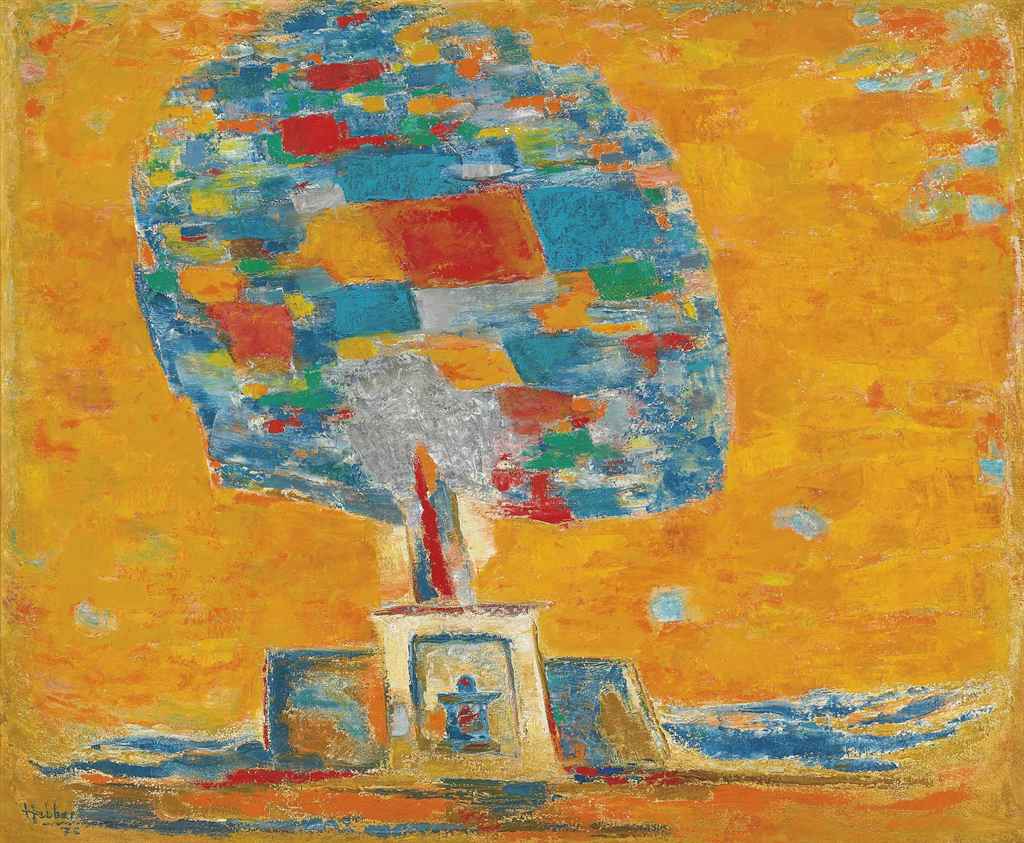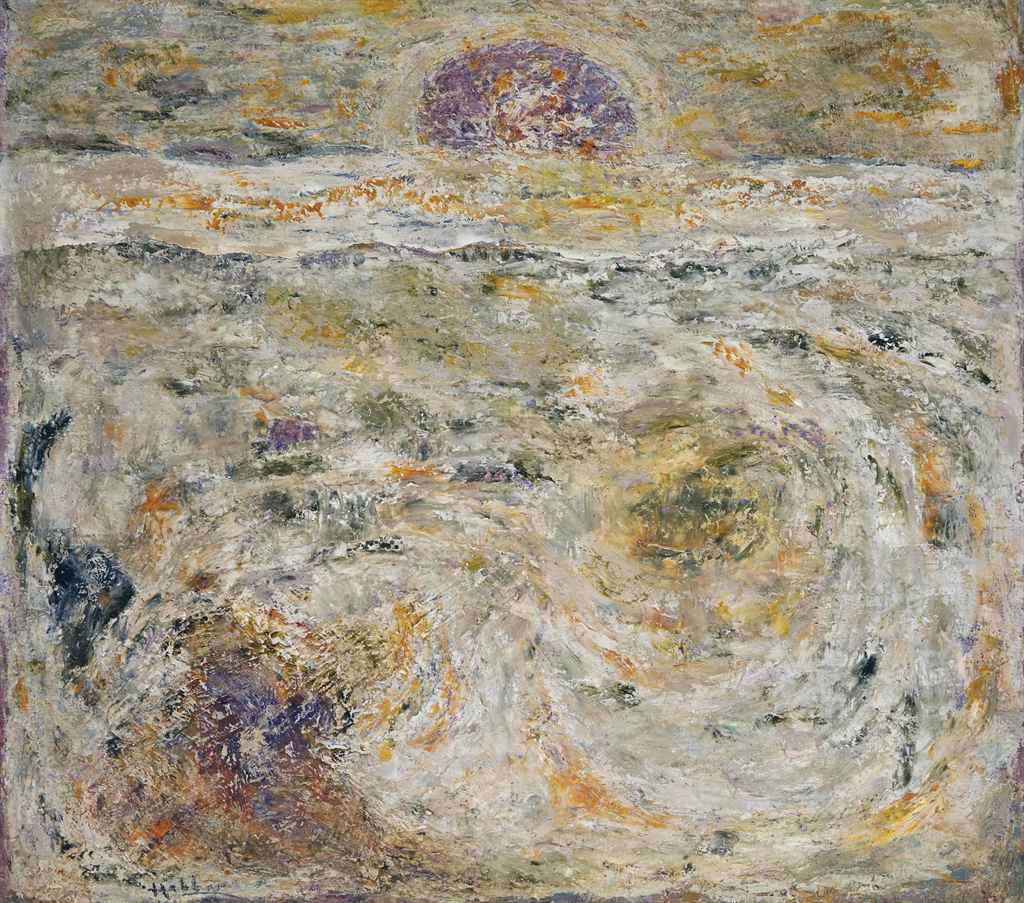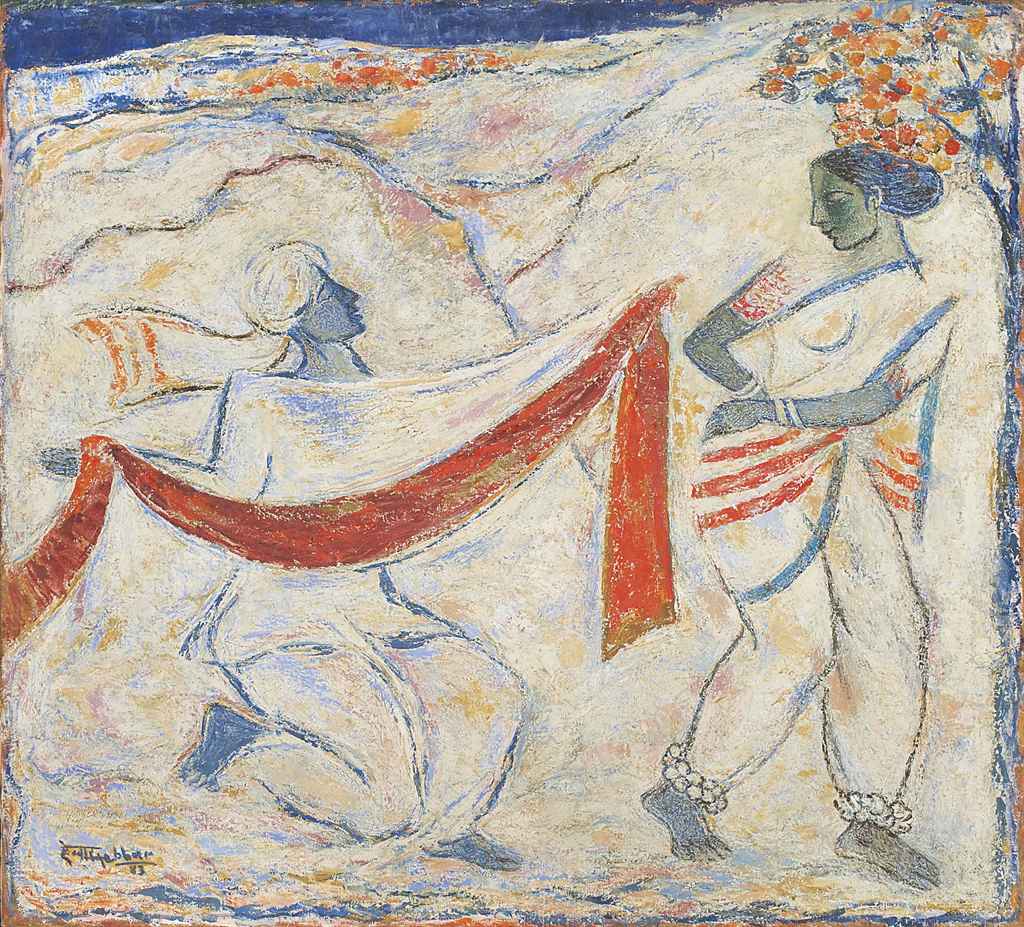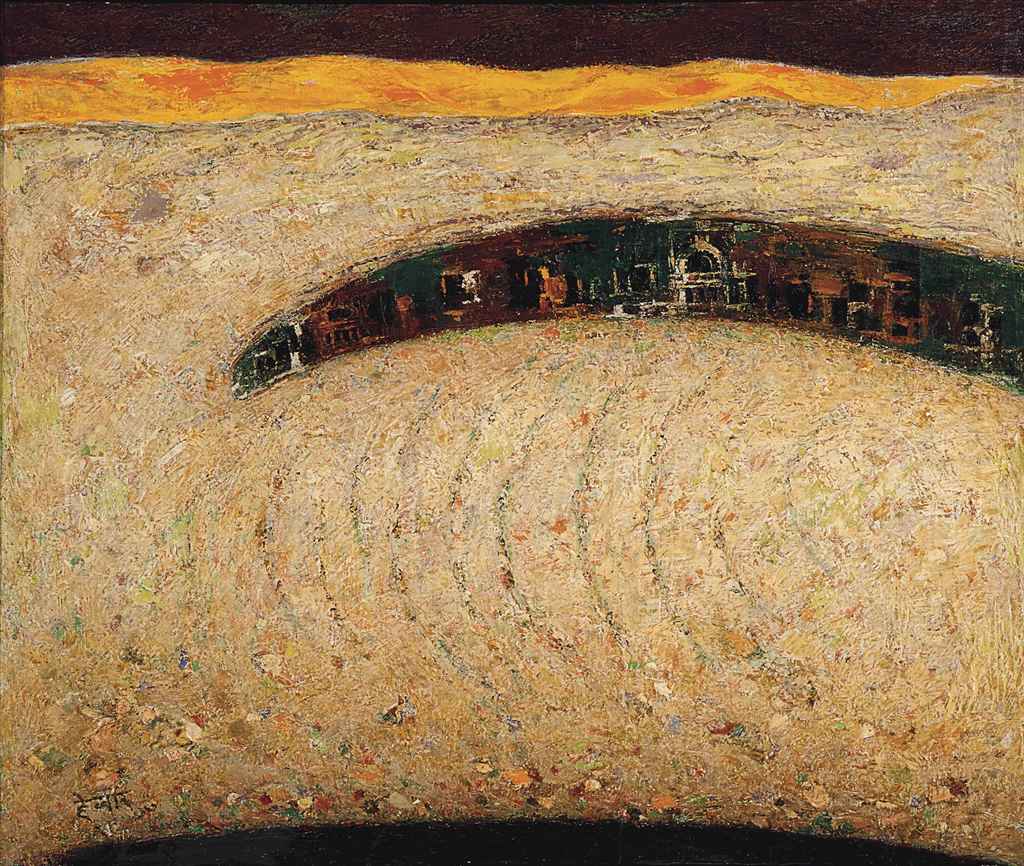Kattingeri Krishna Hebbar (Indian, 1911-1996)Untitled (Veena Player) signed and dated Hebbar '69 lower right oil on canvas, framed 55.1 x 101cm (21 11/16 x 39 3/4in).FootnotesProvenance Acquired from Sotheby's, Indian Art New York, 22 March 2007, lot 80. Born in Kattingeri near Udupi, Karnataka, Hebbar was educated at the local mission school before having to enter employment at the age of fourteen to support his family. Whilst working, his artistic talents were discovered and he formally embarked on his art education aged twenty one, at the Chamarajendra Technical Institute in Mysore. He left shortly thereafter, returned home and worked for a photographer. The photographer upon seeing his artistic abilities encouraged him to go to Bombay and resume his artistic education. In Bombay Hebbar studied at the Nutan Kala Mandir and then joined the Sir J.J School of Art where he obtained his diploma in Art. He then proceeded to work as an art teacher at the School whilst simultaneously continuing with his own artistic practise. His continuously evolving style had numerous influences which included the art of Jain manuscripts, Rajput and Mughal miniatures, the murals at the Ajanta caves, his knowledge of dance, particularly Kathak, which he learnt under the tutelage of Pandit Sunder Prasad for two years, the writings of the art historian Ananda Coomaraswamy and the modernist paintings of Amrita Shergil and Paul Gauguin In the present lot, the impact of modernist art is evident as he does not provide a faithful imitation of the subjects as he did in prior works such as Threshing (Pran Nath Mago Contemporary Art in India: A Perspective, New Delhi, 2001, p.70), influenced by his academic training but rather tries to create art based on imagination and memory. Growing up in the Yakshagana bayalata traditions; a folk dance-drama played in the Northern and Southern districts of Mysore meant that he was surrounded by music, drama and dance. This work can therefore be seen as visual music, with the colours being the sounds and the musician and instrument being subsumed into the sounds. The colours are the focal point, and the work imbibes the soothing qualities of classic Indian music. The lack of defined lines adds to the musicality of the work and illustrates Hebbar's abilities to do away with the training he received in classical anatomy and perspective which would hinder the effect he wanted to create. He perhaps said it best himself, when he said 'to achieve the maximum with the minimum lines.' (Amrita Jhaveri, A Guide to 101 Modern and Contemporary Indian Artists, Mumbai, 2005, p 22). As part of the Bombay Group, which came after the Bombay Progressives and included artists like Laxman Pai Mohan Samant and Shiavax Chavda, Hebbar gained critical acclaim both nationally and internationally. His work Woman Bathing was showcased at the Musée d'Art Moderne de Paris in 1946 and he participated in the Biennales of Venice (1955), São Paulo (1959) and Tokyo (1970). His retrospective was held in 1971 at the Rabindra Bhavan in Delhi and his works are part of the collections of the National Gallery of Modern Art, Delhi; Government Museum, Bangalore; academy of Fine Arts, Kolkatta and Tata Institute of Fundamental Research, Mumbai. In 1961 he was bestowed with the Padma Shri; India's fourth highest civilian honour and 1989 was awarded the Padma Bhushan; India's third highest civilian honour.
Kattingeri Krishna Hebbar (Indian, 1911-1996)Untitled (Veena Player) signed and dated Hebbar '69 lower right oil on canvas, framed 55.1 x 101cm (21 11/16 x 39 3/4in).FootnotesProvenance Acquired from Sotheby's, Indian Art New York, 22 March 2007, lot 80. Born in Kattingeri near Udupi, Karnataka, Hebbar was educated at the local mission school before having to enter employment at the age of fourteen to support his family. Whilst working, his artistic talents were discovered and he formally embarked on his art education aged twenty one, at the Chamarajendra Technical Institute in Mysore. He left shortly thereafter, returned home and worked for a photographer. The photographer upon seeing his artistic abilities encouraged him to go to Bombay and resume his artistic education. In Bombay Hebbar studied at the Nutan Kala Mandir and then joined the Sir J.J School of Art where he obtained his diploma in Art. He then proceeded to work as an art teacher at the School whilst simultaneously continuing with his own artistic practise. His continuously evolving style had numerous influences which included the art of Jain manuscripts, Rajput and Mughal miniatures, the murals at the Ajanta caves, his knowledge of dance, particularly Kathak, which he learnt under the tutelage of Pandit Sunder Prasad for two years, the writings of the art historian Ananda Coomaraswamy and the modernist paintings of Amrita Shergil and Paul Gauguin In the present lot, the impact of modernist art is evident as he does not provide a faithful imitation of the subjects as he did in prior works such as Threshing (Pran Nath Mago Contemporary Art in India: A Perspective, New Delhi, 2001, p.70), influenced by his academic training but rather tries to create art based on imagination and memory. Growing up in the Yakshagana bayalata traditions; a folk dance-drama played in the Northern and Southern districts of Mysore meant that he was surrounded by music, drama and dance. This work can therefore be seen as visual music, with the colours being the sounds and the musician and instrument being subsumed into the sounds. The colours are the focal point, and the work imbibes the soothing qualities of classic Indian music. The lack of defined lines adds to the musicality of the work and illustrates Hebbar's abilities to do away with the training he received in classical anatomy and perspective which would hinder the effect he wanted to create. He perhaps said it best himself, when he said 'to achieve the maximum with the minimum lines.' (Amrita Jhaveri, A Guide to 101 Modern and Contemporary Indian Artists, Mumbai, 2005, p 22). As part of the Bombay Group, which came after the Bombay Progressives and included artists like Laxman Pai Mohan Samant and Shiavax Chavda, Hebbar gained critical acclaim both nationally and internationally. His work Woman Bathing was showcased at the Musée d'Art Moderne de Paris in 1946 and he participated in the Biennales of Venice (1955), São Paulo (1959) and Tokyo (1970). His retrospective was held in 1971 at the Rabindra Bhavan in Delhi and his works are part of the collections of the National Gallery of Modern Art, Delhi; Government Museum, Bangalore; academy of Fine Arts, Kolkatta and Tata Institute of Fundamental Research, Mumbai. In 1961 he was bestowed with the Padma Shri; India's fourth highest civilian honour and 1989 was awarded the Padma Bhushan; India's third highest civilian honour.

.jpg)
.jpg)
.jpg)
.jpg)
.jpg)






Testen Sie LotSearch und seine Premium-Features 7 Tage - ohne Kosten!
Lassen Sie sich automatisch über neue Objekte in kommenden Auktionen benachrichtigen.
Suchauftrag anlegen